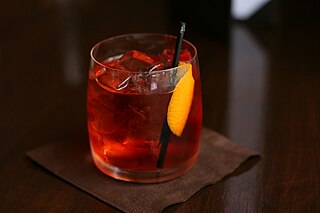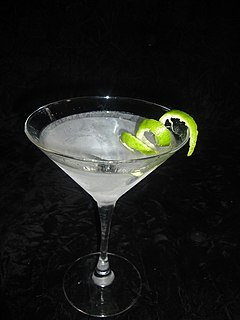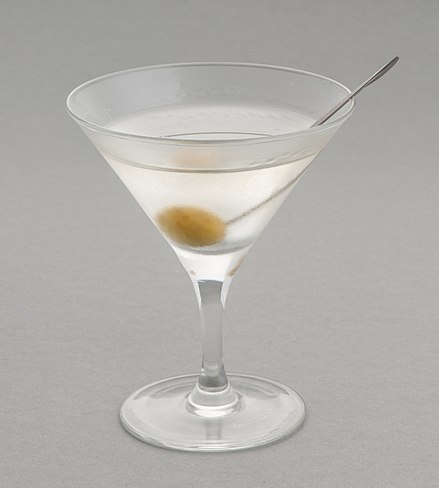
A gin and tonic or, less frequently, gin tonic is a highball cocktail made with gin and tonic water poured over a large amount of ice. The ratio of gin to tonic varies according to taste, strength of the gin, other drink mixers being added, etc., with most recipes calling for between a 1:1 to 1:3 ratio. It is usually garnished with a slice or wedge of lime. To preserve effervescence, the tonic can be poured down a bar spoon. The ice cools the gin, dulling the effect of the alcohol in the mouth and making the drink more pleasant to taste.

A Manhattan is a cocktail made with whiskey, sweet vermouth, and bitters. While rye is the traditional whiskey of choice, other commonly used whiskies include Canadian whisky, bourbon, blended whiskey, and Tennessee whiskey. The cocktail is usually stirred then strained into a cocktail glass and garnished traditionally with a maraschino cherry. A Manhattan may also be served on the rocks in a lowball glass.

The martini is a cocktail made with gin and vermouth, and garnished with an olive or a lemon twist. Over the years, the martini has become one of the best-known mixed alcoholic beverages.

The Negroni is a popular Italian cocktail, made of one part gin, one part vermouth rosso, and one part Campari, garnished with orange peel. It is considered an apéritif.

The Hanky-Panky is a cocktail made from gin, sweet vermouth, and Fernet-Branca.

A sour is a traditional family of mixed drinks. Common examples of sours are the margarita and the sidecar. Sours belong to one of the old families of original cocktails and are described by Jerry Thomas in his 1862 book How to Mix Drinks.

An Apple martini is a cocktail containing vodka and one or more of apple juice, apple cider, apple liqueur, or apple brandy.

A vodka martini, also known as a vodkatini or kangaroo cocktail, is a cocktail made with vodka and vermouth, a variation of a martini.

The gimlet is a cocktail made of gin and lime juice. A 1928 description of the drink was: gin, and a spot of lime. The description in the 1953 Raymond Chandler novel The Long Goodbye stated that "a real gimlet is half gin and half Rose's lime juice and nothing else." This is in line with the proportions suggested by The Savoy Cocktail Book (1930), which specifies one half Plymouth Gin and one half Rose's Lime Juice Cordial. However, modern tastes are less sweet, and generally provide for at least two parts gin to one part of the lime and other non-alcoholic elements.

Various unique terminology is used in bartending.

"Shaken, not stirred" is a catchphrase of Ian Fleming's fictional British Secret Service agent James Bond and describes his preference for the preparation of his martini cocktail.

The Vesper or Vesper Martini is a cocktail that was originally made of gin, vodka, and Kina Lillet. The formulations of its ingredients have changed since its original publication in print, and so some modern bartenders have created new versions which attempt to more closely mimic the original taste.

The Fine Art of Mixing Drinks is a book about cocktails by David A. Embury, first published in 1948. The book is noteworthy for its witty, highly opinionated and conversational tone, as well as its categorization of cocktails into two main types: aromatic and sour; its categorization of ingredients into three categories: the base, modifying agents, and special flavorings and coloring agents; and its 1:2:8 ratio for sour type cocktails.

The Gibson is a mixed drink made with gin and dry vermouth, and often garnished with a pickled onion. In its modern incarnation, it's considered a cousin of the more-ubiquitous martini, distinguished mostly by garnishing with an onion instead of an olive. But the earliest recipes for a Gibson -- including the first known recipe published in 1908 -- are differentiated more by how they treat the addition of bitters.

A Bacon Martini, also known as bacontini, pig on the tocks or a bloody bacon martini, is a cocktail that consists of bacon-infused vodka served with a garnish that can include strips of bacon, bacon bits, or olives. Variants may include the addition of Bloody Mary mix. Although not a vodka martini, which consists of vodka and vermouth, the term "bacon martini" is consistent with the trend of calling any straight liquor in a martini glass a "martini," such as the saketini or other variations.

The Clover Club Cocktail is a cocktail consisting of gin, lemon juice, raspberry syrup, and an egg white. The egg white is not added for the purpose of giving the drink flavor, but rather acts as an emulsifier. Thus when the drink is shaken a characteristic foamy head is formed.

A lemon drop is a vodka-based cocktail that has a lemony, sweet and sour flavor, prepared using lemon juice, triple sec and simple syrup. It has been described as a variant of, or as "a take on", the Vodka Martini. It is typically prepared and served straight up – chilled with ice and strained.

The espresso martini is a cold, coffee-flavored cocktail made with vodka, espresso coffee, coffee liqueur, and sugar syrup. It is not a true martini as it contains neither gin nor vermouth, but is one of many drinks that incorporate the term into their names.

The Martinez is a classic cocktail that is widely regarded as the direct precursor to the Martini. It serves as the basis for many modern cocktails, and several different versions of the original exist. These are generally distinguished by the accompaniment of either Maraschino or Curacao, as well as differences in gin or bitters.


















